The Micro Printing Market is estimated to be valued at USD 816.5 billion in 2025 and is projected to reach USD 1863.2 billion by 2035, registering a compound annual growth rate (CAGR) of 8.6% over the forecast period.
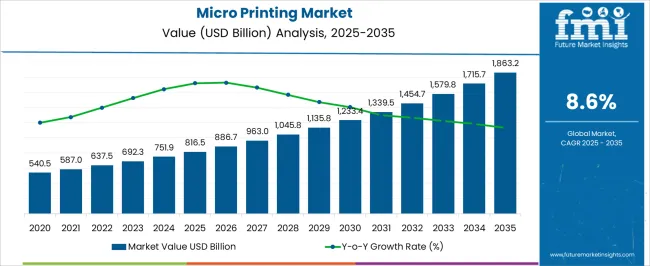
| Metric | Value |
|---|---|
| Micro Printing Market Estimated Value in (2025 E) | USD 816.5 billion |
| Micro Printing Market Forecast Value in (2035 F) | USD 1863.2 billion |
| Forecast CAGR (2025 to 2035) | 8.6% |
The micro printing market is witnessing steady growth, driven by the rising demand for high-precision printing technologies across security, authentication, and industrial applications. Increasing concerns regarding counterfeiting and document forgery are fueling the adoption of advanced micro printing solutions, particularly in the currency and secure document sectors. Technological advancements in printing processes, including micro-embossing and laser-assisted techniques, are enabling higher accuracy and finer resolution, which enhance product security and reliability.
Growing investments by governments and financial institutions in secure printing systems are further supporting market expansion. In addition, the integration of micro printing with digital authentication systems and anti-counterfeiting measures is broadening its applicability beyond currency to certificates, legal documents, and brand protection labels.
Rising awareness of fraud prevention and increasing regulatory standards for security printing are expected to sustain demand As the need for secure printing solutions escalates globally, manufacturers are focusing on innovative technologies and precision printing methods, positioning the market for consistent long-term growth.
The micro printing market is segmented by type, application, and geographic regions. By type, micro printing market is divided into Micro-Embossing, Special Inks, Magnetic Inks, UV Invisible Inks, Infrared Ink Marking, and Others. In terms of application, micro printing market is classified into Currency, Stamps, Bank Checks, Labels, Defense, Packaging, ID Cards, Consumer Electronics, and Others. Regionally, the micro printing industry is classified into North America, Latin America, Western Europe, Eastern Europe, Balkan & Baltic Countries, Russia & Belarus, Central Asia, East Asia, South Asia & Pacific, and the Middle East & Africa.
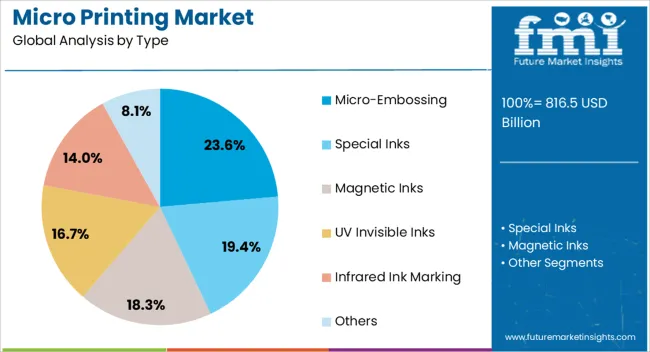
The micro-embossing segment is projected to hold 23.6% of the micro printing market revenue share in 2025, making it the leading type segment. Its growth is being supported by the ability to create highly precise raised patterns that are difficult to replicate, which enhances security features for sensitive documents and currency. The technique allows for fine detailing at micron-level resolution, providing both functional and aesthetic advantages in secure printing applications.
Rising adoption is being driven by increasing demand for tamper-proof and counterfeit-resistant solutions in financial, legal, and corporate sectors. Technological advancements have improved production efficiency and repeatability, reducing costs while maintaining high-quality output.
As security standards continue to evolve, micro-embossing is increasingly preferred due to its adaptability, reliability, and compatibility with other security features The segment’s prominence is further reinforced by its ability to deliver complex designs without compromising material integrity, ensuring long-term durability and widespread adoption across global markets.
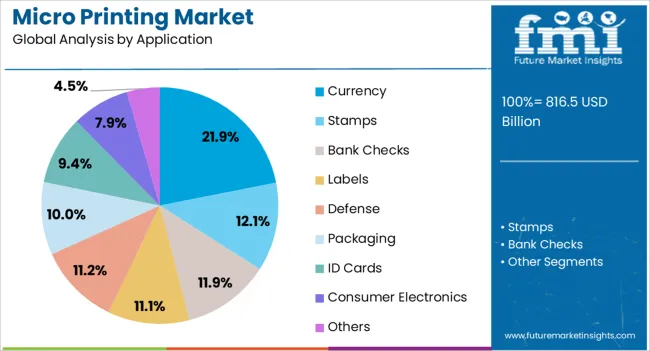
The currency application segment is anticipated to account for 21.9% of the micro printing market revenue share in 2025, establishing it as the leading application area. Its dominance is being driven by the critical need for enhanced security features to prevent counterfeiting and maintain public trust in financial systems. Micro printing is employed to integrate fine text, intricate patterns, and embossed designs that are extremely difficult to replicate, providing robust anti-counterfeiting protection.
The segment is further supported by regulatory requirements that mandate the inclusion of high-security printing techniques in banknotes worldwide. Increasing issuance of polymer and hybrid currency notes that incorporate micro printing features is also accelerating adoption.
Financial institutions are prioritizing advanced micro printing methods that can be combined with other authentication technologies such as watermarks, holograms, and optically variable inks Rising investments in currency security and global expansion of secure printing solutions are expected to sustain growth, positioning the currency application segment as a major driver of the micro printing market over the forecast period.
The micro printing market demand is estimated to grow at an 8.6% CAGR between 2025 and 2035 in comparison with 2.8% CAGR registered during the historic period (2025-2025).
The micro-printing process is widely accepted in various industries, especially for improving the security of employee ID cards and driver's licenses, thus boosting the growth of the micro printing market. Currencies and stamps are both obvious growths in the micro printing market. Various government policies and agencies aimed at improving the security of currency and certificates are boosting the growth of the micro-printing market. In addition, advances in ingenious Micro printing coupled with cost-effective techniques have enhanced their applications in various industries. These factors are likely to boost the growth of the micro printing market.
Micro printing is gaining momentum in the development of the characters and identical patterns with the advent of the new printers such as copiers, image scanning systems and pantographs.
There has been a significant increase in R&D activity to extend and innovate the range of micro printing systems. Players in the micro printing market have strived to increase the attractiveness of their products by balancing budget constraints that affect system sales.
As a result, a low-cost micro-printing technology was developed that reduced the cost per print and increased the print speed per hour. This has impacted the adoption rate of these printers and is expected to remain so for the next few years and contributing to the growing size of the microprinting market.
The East Asian regional market is estimated to grow by CAGR of 10.1% during the forecast period of 2025-2035 and the largest market share was held by North America of 23.3% in 2025.
East Asia's micro printing market held over 21.1% revenue share in 2025. This is due to the increased adoption of technology in various industries such as banking and finance, government agencies and corporate organizations. Demand for security and anti-counterfeiting solutions is expected to increase in education, enterprise, and government sectors, thereby driving the growth of the regional market.
North America has a large population, with strong economic conditions and has a large market for consumer electronics, packaging and ID cards.
The China micro printing market accounted for the highest market share of 17.8% in 2025. This is due to the biggest population with increased adoption of e-commerce sector which emphasises risk for fraud and introduction of counterfeit currency are the factors driving the growth of the micro printing market in China.
Rising sales of consumer electronics in China coupled with exports to numerous countries are expected to increase the acceptance rate of micro-printing systems for labelling products and their packaging. In addition, China's established banking sector uses these systems extensively for printing currency and designing check books.
The market for micro printing in India is estimated to grow at highest CAGR of 10.4% during the forecast period. owing to growing demand for microprinting of official and government documents such as ID cards, driver's licenses, passports, etc. The Indian market is booming due to the growing demand for microprinting to prevent fraud and the introduction of counterfeit currency in banks, financial institutions, government agencies and businesses.
Rise in financial fraud activities using counterfeit currency has increased the need for micro-printing devices, which is expected to provide lucrative growth opportunities for the Indian micro-printing market.
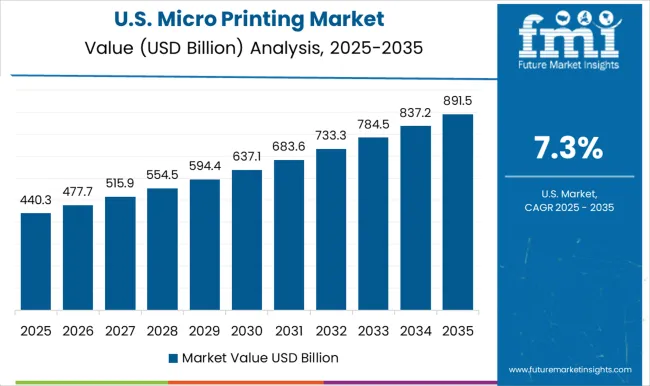
The USA is predicted to remain the most attractive market during the forecast period. According to the study, the USA micro-printing market is set to account for nearly 12.5% market share of total North America region.
The USA is home to many banks, government financial institutions, and corporate organizations, which has increased the use of printers based on micro printing technology. Increased development activities and rapid economic expansion in the USA are expected to witness high growth of the micro printing market. In addition, banking sector standards and regulations, expanding e-commerce sector, and technological advancements in micro-printing technology in the BFSI sector are key factors driving the growth of the USA micro-printing market.
The market for UV invisible ink in micro printing is estimated to grow at highest CAGR of 9.8% during the forecast period. UV invisible ink are fluorescent. That is these inks are invisible to naked eye but appear to glow under blacklight or UV.
In recent years, UV invisible ink which is also known as invisible ink has rapidly developed. Moreover, micro printing is widely used for anti-counterfeiting with UV Invisible Inks playing an important role in the micro printing of stamps and currency. The consistent growth in printing currency, postage stamps and bank documents has also helped UV invisible inks micro printing grow at a significant rate.
Packaging application to hold largest market share of micro printing market during forecast period which is accounted for 17.5% in 2025. Micro printing is currently implemented on packages, boxes, tags, and labels used in packaging applications. Packaging applications require high-quality printing, security, rapid product identification and fast print turnaround times. All industries need product security and brand protection as counterfeit products can impact annual sales.
Therefore, industry players are now focused on implementing the micro printing in packaging applications to enable product security and avoid product duplication. Therefore, the micro printing market for packaging applications is expected to drive the market for micro printing.
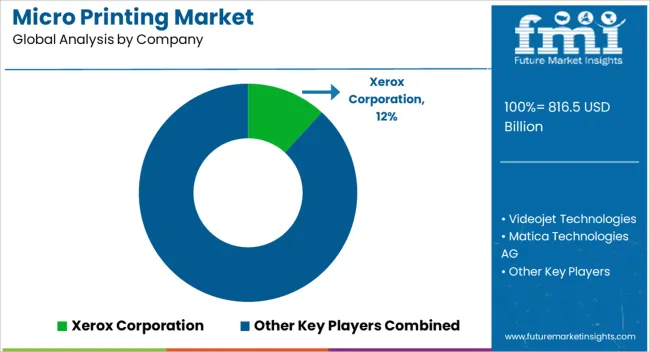
Acquisitions and mergers are the default expansion strategies of players operating in the micro printing market. In the micro printing market, we are also seeing trends in the development of novel printers that utilize cutting-edge technology and eco-friendly printers. For instance,
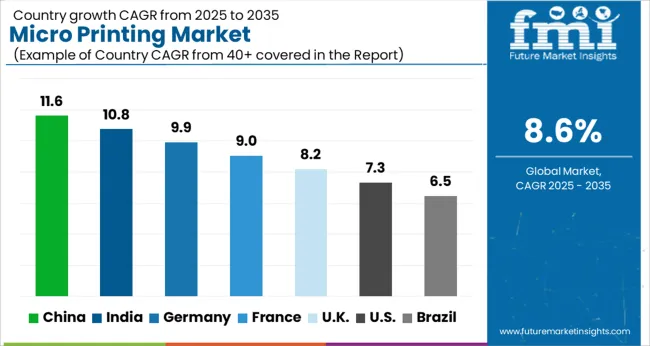
| Country | CAGR |
|---|---|
| China | 11.6% |
| India | 10.8% |
| Germany | 9.9% |
| France | 9.0% |
| UK | 8.2% |
| USA | 7.3% |
| Brazil | 6.5% |
The Micro Printing Market is expected to register a CAGR of 8.6% during the forecast period, exhibiting varied country level momentum. China leads with the highest CAGR of 11.6%, followed by India at 10.8%. Developed markets such as Germany, France, and the UK continue to expand steadily, while the USA is likely to grow at consistent rates. Brazil posts the lowest CAGR at 6.5%, yet still underscores a broadly positive trajectory for the global Micro Printing Market. In 2024, Germany held a dominant revenue in the Western Europe market and is expected to grow with a CAGR of 9.9%. The USA Micro Printing Market is estimated to be valued at USD 287.3 billion in 2025 and is anticipated to reach a valuation of USD 581.8 billion by 2035. Sales are projected to rise at a CAGR of 7.3% over the forecast period between 2025 and 2035. While Japan and South Korea markets are estimated to be valued at USD 42.7 billion and USD 23.5 billion respectively in 2025.
| Item | Value |
|---|---|
| Quantitative Units | USD 816.5 Billion |
| Type | Micro-Embossing, Special Inks, Magnetic Inks, UV Invisible Inks, Infrared Ink Marking, and Others |
| Application | Currency, Stamps, Bank Checks, Labels, Defense, Packaging, ID Cards, Consumer Electronics, and Others |
| Regions Covered | North America, Europe, Asia-Pacific, Latin America, Middle East & Africa |
| Country Covered | United States, Canada, Germany, France, United Kingdom, China, Japan, India, Brazil, South Africa |
| Key Companies Profiled | Xerox Corporation, Videojet Technologies, Matica Technologies AG, Team NiSCA, Ricoh Company Ltd., Saueressig GmbH Co KG, Hewlett-Packard Company, Brady Corporation, Printegra, Gallas Label & Decal, Source Technologies, SAFEChecks, Domino Printing Sciences PLC, Control Print Ltd., and Data Carte Concepts |
The global micro printing market is estimated to be valued at USD 816.5 billion in 2025.
The market size for the micro printing market is projected to reach USD 1,863.2 billion by 2035.
The micro printing market is expected to grow at a 8.6% CAGR between 2025 and 2035.
The key product types in micro printing market are micro-embossing, special inks, magnetic inks, uv invisible inks, infrared ink marking and others.
In terms of application, currency segment to command 21.9% share in the micro printing market in 2025.






Our Research Products

The "Full Research Suite" delivers actionable market intel, deep dives on markets or technologies, so clients act faster, cut risk, and unlock growth.

The Leaderboard benchmarks and ranks top vendors, classifying them as Established Leaders, Leading Challengers, or Disruptors & Challengers.

Locates where complements amplify value and substitutes erode it, forecasting net impact by horizon

We deliver granular, decision-grade intel: market sizing, 5-year forecasts, pricing, adoption, usage, revenue, and operational KPIs—plus competitor tracking, regulation, and value chains—across 60 countries broadly.

Spot the shifts before they hit your P&L. We track inflection points, adoption curves, pricing moves, and ecosystem plays to show where demand is heading, why it is changing, and what to do next across high-growth markets and disruptive tech

Real-time reads of user behavior. We track shifting priorities, perceptions of today’s and next-gen services, and provider experience, then pace how fast tech moves from trial to adoption, blending buyer, consumer, and channel inputs with social signals (#WhySwitch, #UX).

Partner with our analyst team to build a custom report designed around your business priorities. From analysing market trends to assessing competitors or crafting bespoke datasets, we tailor insights to your needs.
Supplier Intelligence
Discovery & Profiling
Capacity & Footprint
Performance & Risk
Compliance & Governance
Commercial Readiness
Who Supplies Whom
Scorecards & Shortlists
Playbooks & Docs
Category Intelligence
Definition & Scope
Demand & Use Cases
Cost Drivers
Market Structure
Supply Chain Map
Trade & Policy
Operating Norms
Deliverables
Buyer Intelligence
Account Basics
Spend & Scope
Procurement Model
Vendor Requirements
Terms & Policies
Entry Strategy
Pain Points & Triggers
Outputs
Pricing Analysis
Benchmarks
Trends
Should-Cost
Indexation
Landed Cost
Commercial Terms
Deliverables
Brand Analysis
Positioning & Value Prop
Share & Presence
Customer Evidence
Go-to-Market
Digital & Reputation
Compliance & Trust
KPIs & Gaps
Outputs
Full Research Suite comprises of:
Market outlook & trends analysis
Interviews & case studies
Strategic recommendations
Vendor profiles & capabilities analysis
5-year forecasts
8 regions and 60+ country-level data splits
Market segment data splits
12 months of continuous data updates
DELIVERED AS:
PDF EXCEL ONLINE
Microprinting Market Size and Share Forecast Outlook 2025 to 2035
Micro-Vent Cap Systems Market Analysis - Size and Share Forecast Outlook 2025 to 2035
Microfilm Readers and Scanners Market Size and Share Forecast Outlook 2025 to 2035
Micron CBN Powder Market Size and Share Forecast Outlook 2025 to 2035
Microfilm Reader Market Size and Share Forecast Outlook 2025 to 2035
Printing Paper Market Size and Share Forecast Outlook 2025 to 2035
Micro-Dosing Sachet Fillers Market Analysis - Size and Share Forecast Outlook 2025 to 2035
Microbial Growth Monitoring System Market Size and Share Forecast Outlook 2025 to 2035
Micro Hotel Market Forecast and Outlook 2025 to 2035
Microwave Source Market Size and Share Forecast Outlook 2025 to 2035
Micro-energy Harvesting System Market Size and Share Forecast Outlook 2025 to 2035
Micro CHP Market Size and Share Forecast Outlook 2025 to 2035
Micro Irrigation System Market Size and Share Forecast Outlook 2025 to 2035
Micro Flute Paper Market Size and Share Forecast Outlook 2025 to 2035
Microcrystalline Cellulose Market Size and Share Forecast Outlook 2025 to 2035
Micro Balances Market Size and Share Forecast Outlook 2025 to 2035
Micro Perforated Films Packaging Market Size and Share Forecast Outlook 2025 to 2035
Microbial Coagulants Market Size and Share Forecast Outlook 2025 to 2035
Microserver IC Market Size and Share Forecast Outlook 2025 to 2035
Microplate Handling Instruments Market Size and Share Forecast Outlook 2025 to 2035

Thank you!
You will receive an email from our Business Development Manager. Please be sure to check your SPAM/JUNK folder too.
Chat With
MaRIA